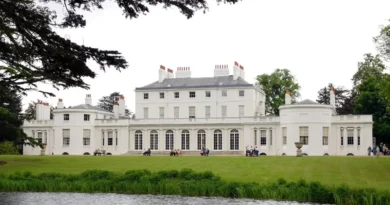I. Introduction
On November 20, 1992, a fire broke out at Windsor Castle, the largest inhabited castle in the world and one of the official residences of the British Monarch. The fire began in the Queen Victoria’s private chapel. It quickly spread to the neighbouring Brunswick Tower, St George’s Hall banqueting space, and the private apartments in the eastern wing of the building. The main fire burned for almost 12 hours, causing severe damage and making headline news worldwide.
II. The Cause of the Fire
The cause of the fire was never definitively determined. Still, it is believed to have started in a spotlight in the Queen’s private chapel. The spotlight had been left on overnight to heat the chapel for a service the next morning. It is thought that the spotlight may have overheated and caused the surrounding curtains to catch fire.
III. The Extent of Damage to Windsor Castle Due to the 1992 Fire

A. Structural Damage
The primary devastation resulted from the fire’s impact on the castle’s structure. The fire spread due to the presence of a false ceiling in St.
George’s Hall and the space underneath the floor were designed for coal trucks. It extended as far as the Chester Tower and caused several ceilings to collapse.
Notable rooms that suffered severe damage included the Crimson Drawing Room (completely gutted), the Green Drawing Room (heavily damaged, although not entirely destroyed by smoke and water), and the Queen’s Private Chapel, which housed the double-sided 19th-century Henry Willis organ located in the gallery between St. George’s Hall and Private Chapel, along with oak panelling, glass, and the altar.
While the walls of St. George’s Hall largely remained intact, the ceiling had collapsed. The State Dining Room in the Prince of Wales Tower and the Grand Reception Room also endured significant devastation.
St. George’s Chapel at Windsor Castle in History & Today
Note: The Prince of Wales Tower is a lesser-known tower within Windsor Castle, likely dating back to the 14th century. It functioned as a defensive element, offering a lookout point and potentially housing soldiers. While details about its past uses are limited, the tower is a testament to the castle’s evolution and role in English history.
In total, around 100 rooms were impacted by the fire. Smaller apartments that suffered damage or were completely destroyed included the Octagon Room, Brunswick Tower (buried under 12 feet of debris), Star Chamber, Prince of Wales Tower, Holbein Room, Cornwall Tower, Chester Tower, and the Great Kitchen, which lost its plaster coving and a significant portion of its medieval timber.
The external wall above the bay window of the Crimson Drawing Room, situated between the Prince of Wales and Chester Towers, sustained serious calcification.
- Also, read The Windsor Castle Fire 1992: A Historical Catastrophe.
- Are Babies Free for Windsor Castle
B. Loss of Contents
Among the most seriously damaged rooms, valuable contents had been removed the day before the fire. Some paintings were on loan for a travelling exhibition.
Lost items from the Royal Collection included Sir William Beechey’s large equestrian portrait of George III and the Prince of Wales Reviewing Troops, which measured 13 feet by 16 feet and was too large to evacuate.
Additional losses encompassed an 18-foot-long sideboard from the 1820s crafted by Morel and Seddon, various pieces of the Willis organ, porcelain, chandeliers, and partial damage to the 1851 Great Exhibition Axminster carpet. Peter Brooke, then Secretary of State for National Heritage, characterized the fire as a national disaster.
Some of the most valuable items lost in the fire included:
- A large equestrian portrait of George III and the Prince of Wales Reviewing Troops by Sir William Beechey
- An 18-foot-long sideboard from the 1820s crafted by Morel and Seddon
- Various pieces of porcelain
- Chandeliers
- The Willis organ
- Partial damage to the 1851 Great Exhibition Axminster carpet
- Also, read Devastating Timeline of the Windsor Castle Fire 1992.
- Also, read The Windsor Castle Fire Salvage Operation 1992.
C. Tourism

Tourists were permitted access to the castle precincts within three days of the fire. The Queen returned to her residence at Windsor Castle a fortnight later. In December, The Gallery and Queen Mary’s Dolls’ House were reopened.
The State Apartments were gradually reopened in 1993 after rewiring was completed. By Easter, all the major rooms were accessible to the public except St. George’s Hall and the Grand Reception Room, which remained closed. This meant eleven out of fifteen principal rooms in the State Apartments were available, while two were undergoing long-term restoration, and two had been completely destroyed.
- Also, read Windsor Castle Tour: A Comprehensive and Best Guide.
- Also, read Windsor Castle Tickets Advantage Card: Know Everything.
- Also, read How Far is Windsor Castle from Buckingham Palace? Royal Mile?
D. Additional Damages
- The fire caused extensive damage to the castle’s electrical wiring and plumbing. This damage required significant repairs and replacements.
- The fire also caused damage to the castle’s heating and cooling system. This damage also required significant repairs and replacements.
- In addition, the fire caused smoke and water damage to many castle areas. This damage required cleaning and restoration work.
- The total cost of the restoration work was £36.5 million. This money came from various sources, including the government, the Royal Family, and public donations.
- Also, read Windsor Castle Opening Times: Everything You Need to Know.
- Also, read Windsor Castle Tickets: A Proven Comprehensive Guide.
IV. The Restoration of Windsor Castle

The restoration work was completed in 1997, and the castle was reopened to the public. The castle is now a popular tourist destination, and it is a symbol of British history and culture.
V. The Impact of the Fire
The fire at Windsor Castle significantly impacted the British royal family and the nation. The fire caused extensive damage to the castle, one of the UK’s most important and historic buildings. The fire also came when the royal family faced several challenges, including the divorces of three of the Queen’s children.
VI. Conclusion
The fire at Windsor Castle was a devastating event. Still, it also showed the resilience of the British royal family and the nation. The castle was restored to its former glory and remains one of the most popular tourist attractions in the UK.
- Also, read Windsor Castle Changing of the Guard
VII. FAQs
1. What specific challenges and complexities were encountered during the restoration of Windsor Castle following the 1992 fire beyond the structural and content-related damages mentioned in the article?
The restoration of Windsor Castle after the 1992 fire was complex and challenging. Some of the challenges and complexities that were encountered included:
- The sheer scale of the damage: The fire damaged over 100 rooms, including nine State Rooms. The State Rooms are some of the castle’s most important and historic rooms, and they are used for official receptions and banquets. The fire also caused extensive damage to the St George’s Hall banqueting space and the private apartments in the eastern wing of the castle.
- The need to balance conservation with restoration: The restoration team had to carefully balance the need to conserve the castle’s original fabric with the need to restore it to its former glory. This was a delicate process, as the fire had damaged or destroyed many of the castle’s original features.
- The need to work around the royal family’s schedule: The royal family still uses Windsor Castle as a residence, so the restoration team had to work around their schedule and minimize disruption to their lives. This was a challenge, as the restoration work was extensive and time-consuming.
- The need to raise funds: The cost of the restoration work was estimated at £36.5 million. This was a significant amount of money, and the restoration team had to raise funds from various sources, including the government, the Royal Collection Trust, and public donations.
Despite these challenges and complexities, the restoration team completed the restoration of Windsor Castle to its former glory. The castle was reopened in 1997 and is now a popular tourist destination.
- Also, read 12 High-Quality Luxury Hotels In London.
- Also, read 25 Best Historical Places to Visit in the UK.
- Also, read Things to Do in London on Christmas.
- Also, read Kingston upon Thames.
2. What additional historical or cultural significance does Windsor Castle hold in British history, and how did the 1992 fire affect its role as a symbol of British heritage beyond its physical damage?

Windsor Castle is one of the most important and historic buildings in the United Kingdom. It has been a royal residence for over 900 years. British monarchs have used it for various purposes, including government, entertainment, and military defence.
Windsor Castle has significantly influenced many important events in British history. For example, it was the site of the signing of the Magna Carta in 1215, and it was used as a prison during the English Civil War in the 17th century.
The castle has also been a popular setting for royal weddings and other important ceremonies. For example, Queen Victoria and Prince Albert were married at Windsor Castle in 1840, and Prince Charles and Princess Diana were married there in 1981.
The 1992 fire caused Windsor Castle’s extensive damage but did not destroy its historical and cultural significance. The fire may have even strengthened the castle’s role as a symbol of British heritage.
The fire was a major event in British news, attracting much public attention. This attention helped raise awareness of the castle’s importance. It led to a surge in public donations to help with the restoration work.
The fire also showed the resilience of the British people. The castle was restored to its former glory and is now more popular. The fire may have damaged the castle physically, but it did not damage its spirit.
In the years since the fire, Windsor Castle has continued to be a popular tourist destination and a symbol of British heritage. It is a reminder of the country’s long and rich history and a place where people from all over the world come to learn about British culture.
In addition to its historical and cultural significance, Windsor Castle is also an important economic asset for the United Kingdom. The castle attracts millions of visitors each year and generates a significant amount of revenue for the local economy. It is also a major employer in the area and supports a variety of businesses, including hotels, restaurants, and shops.
Windsor Castle is vital to British history, culture, and economy. The 1992 fire may have caused significant damage to the castle. Still, it did not destroy its importance or its role as a symbol of British heritage.
- Also, read Kingston Upon Thames History – Hidden London.
- Also, read What Does Buckingham Palace Look Like?
- Also, read Blenheim Palace: A Majestic Walled Garden.
- Also, read The Bishop’s Palace And Gardens – An Ultimate Place.
3. Were there any significant long-term cultural or architectural changes implemented during the restoration of Windsor Castle after the fire, which was not mentioned in the provided article?
Yes, there were. One of the most significant long-term cultural changes was the decision to open up more of the castle to the public. Before the fire, only a limited selection of State Apartments were accessible. However, after the restoration, the public gained access to a larger portion, including the Semi-State Rooms and the Private Chapel. This change allows visitors a deeper appreciation for the castle’s history and significance.
The restoration also included some architectural changes that aimed to balance historical accuracy with functionality. For instance, the State Dining Room was redesigned to accommodate larger gatherings, reflecting its historical purpose. However, sources from the Royal Collection Trust suggest the primary focus was on restoring its original grandeur rather than simply increasing size.
Similarly, the Grand Reception Room underwent a redesign. While some accounts might mention a new staircase, the emphasis from the Royal Collection Trust seems to be on restoring the room’s original splendor, ensuring it aligns with the rest of the castle’s grandeur.
These changes have undoubtedly made Windsor Castle a more welcoming and accessible space for visitors. They also contribute significantly to preserving the castle’s history and cultural significance for future generations.










Comments are closed.